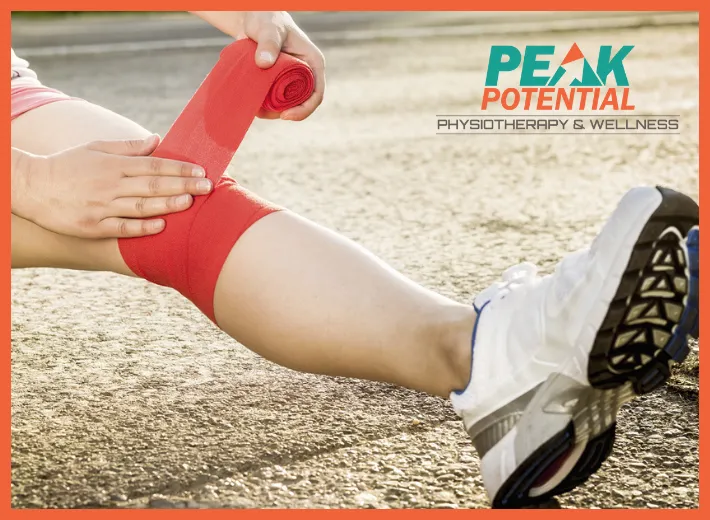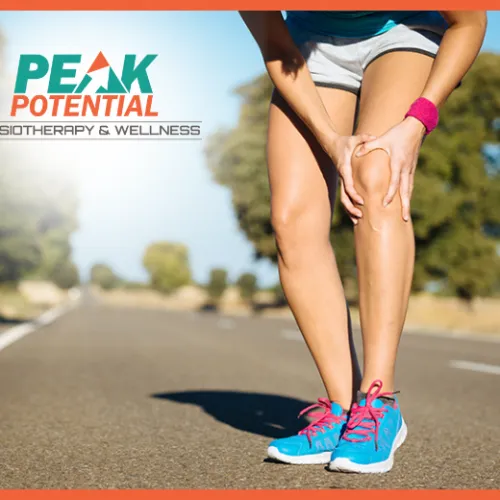This article provides helpful information for athletes or anyone suffering from a meniscus tear. It provides eight exercises that can help improve the strength and flexibility of the knee joint and potentially speed up the healing process. These exercises can be incorporated into a rehabilitation plan, under the guidance of your physical therapist — that’s us! Connect with us for a consultation so we can help determine exactly the right path for you, personalized.
What is a meniscus tear?
A meniscus tear is a common knee injury that often affects people who play contact sports. It can also be caused by wear and tear and doing everyday activities that put pressure on the knee joint, such as squatting to pick something up or getting in and out of a car.
This injury occurs when a person tears the protective cartilage in the knee.
A meniscus tear isn’t always painful, but it can cause swelling and instability in the knee. The knee may lock, and you may have trouble moving it.
The nature of the injury, and a person’s symptoms, help a doctor determine treatments for a meniscus tear. For example, younger people and those who’ve experienced a traumatic injury are more likely to require surgery than older people who have a chronic meniscus injury.
Doctors will often recommend physical therapy exercises to help stabilize the joint.
8 exercises to try
Once you have your doctor’s approval to begin exercising, try some of these exercises to enhance your strength and stability following a meniscus tear.
1. Quadriceps setting
Quadriceps setting is an isometric exercise to strengthen the front thigh muscles.
The steps:
- Sit on the ground with your legs extended in front of you. You can also lie flat, if preferred.
- Focus on tightening or contracting the quadriceps. You can accomplish this by imagining you’re pushing the back of your knee against the floor.
- Hold the muscle contraction for 10 to 20 seconds.
- Repeat 10 times. Rest for 30 seconds to 1 minute, then repeat the steps.
2. Mini-squats
Mini-squats are another type of exercise that can strengthen the quadriceps.
The steps:
- Stand with your back against a wall, with your shoulders and head against the wall. Your feet should be shoulder-width apart and 1 foot from the wall.
- Bend your knees slightly to bring your buttocks toward the ground.
- Stop at about 15 degrees of bend, feeling the muscles in your thighs working.
- Don’t let your squat go so deep that your thighs are parallel to the floor. This puts too much pressure
- on your knees during healing of this injury.
- This puts too much pressure on your knees during healing of this injury.
- Hold this position for 10 seconds, then slowly slide your body back to your starting position.
- Repeat 8 to 10 times. Rest for 30 seconds to 1 minute, then repeat the steps.
You don’t always have to do this exercise against a wall, but it does add greater stability. You can also hold on to a sturdy piece of furniture for balance.
3. Straight leg raise
This exercise both strengthens the quadriceps and stretches the hamstrings, or the muscles that run up the backs of your thighs.
The steps:
- Lie on the floor with your left foot flat on the floor and your right leg extended. Keep your back and pelvis in a neutral position. Your pelvis should be slightly tucked to support your back.
- Flex your right foot and tighten your thigh muscles. Slowly, in a controlled fashion, raise your right leg off the floor.
- Lift the right leg to roughly 45 degrees, or when your right knee is the same height as your left knee.
- Lower the right leg. Do 25 total repetitions. Repeat the exercise on the left leg.
4. Hamstring heel digs

This exercise works to strengthen the hamstrings and challenge the abdominal muscles.
The steps:
- Lie on your back with your knees bent and feet flat on the floor.
- Flex your feet so only your heels are touching the ground.
- Dig your heels into the ground and slowly slide them about 4 to 6 inches away from your body.
- Bring your heels back toward your body, returning to your starting position. You should feel the exercise work the backs of your thighs.
- Repeat this exercise 8 to 10 times, then rest for 30 seconds to 1 minute. Do an additional set.
5. Leg extensions
This exercise can be performed while seated, which means you can do it almost anywhere. Try to do a set two to three times a day.
The steps:
- Sit on a sturdy chair or bench with your feet flat on the floor.
- Flex your right foot and lift your foot off the floor, straightening your right leg. You should feel the muscles in the front of your thigh working.
- Slowly lower the foot to your starting position.
- Repeat 10 times on the right side, then on the left leg. You can also try performing the exercise with a pointed foot.
- Only extend/straighten the knee as far as you can without pain.
6. Standing heel raises
This exercise strengthens your gastrocnemius and soleus muscles, which together make up your calf muscles.
The steps:
- Stand your feet hip-width distance apart with your hands resting lightly on a chair or counter for support.
- Slowly lift your heels up off the floor and rise onto the balls of your feet.
- Pause at the top, and then slowly lower your heels back down to the ground.
- Do 2 to 3 sets, with 8 to 10 reps per set.
Tips: Tighten your gluteus (buttocks) muscles for balance. Keep your ankles in a neutral position to prevent them from rolling towards the outer edges of your feet.
7. Clams
This exercise targets your hip abductors. It helps you strengthen your gluteus medius and gluteus minimus muscles.
The steps:
- Lie on your uninjured side, with your hips stacked on top of one another and your knees bent at a 45-degree angle. Engage your core.
- Rest your head on your lower arm, and use your top arm to stabilize your position.
- Keep your feet stacked on top of one another at all times, and slowly raise your top knee as far as possible without moving your low back and pelvis.
- Slowly return your top knee to its starting position.
- Do 2 to 3 sets with 8 to 12 reps per set.
Tip: Your top hip may want to migrate backwards during the exercise. Try to keep your hips stacked on top of one another and as still as possible.
Too easy? Wrap a resistance band around your thighs before beginning the exercises.
8. Hamstring curls
This exercise strengthens the muscles on the backs of your thighs.
The steps:
- Lie on your stomach with your legs straight. You can rest your forehead on your arms.
- Slowly bend your knee to lift the foot of your injured side toward your buttocks.
- Slowly lower your foot back down to the floor.
- Do 2 to 3 sets with 8 to 10 reps per set.
Exercises to avoid
Doctors will usually advise against performing certain exercises when you have a meniscus tear. These exercises can put too much pressure on an already unstable knee.
Avoid exercises that involve:
- pivoting
- deep squatting
- twisting
If any exercise causes you pain or makes your knee feel unstable, stop doing it right away.
Types of tears
Inside the knee are protective cartilages, including the articular and meniscal cartilage, which cushion the joints and provide stability.
The articular cartilage provides for smooth joint movement. The meniscal cartilage improves the load-bearing abilities of the knee.
Doctors usually divide meniscal tears into two categories: acute traumatic tears and degenerative tears.
Acute trauma
An acute traumatic tear most commonly occurs in young athletes.
You may hear a popping sound upon injuring your knee. Other symptoms of an acute traumatic tear include:
- catching or locking of the joint
- joint pain
- swelling
Degenerative tear
A degenerative tear is caused by repeated stress that weakens the cartilage. These tears occur over time and are most commonly seen in people who are middle-aged.
The symptoms of a chronic meniscal tear are similar to those of an acute tear.
Differing treatment
It’s important to know the differences between the tears because usually only acute traumatic tears are surgically repairable.
Less than 10 percent of meniscal tears occurring in patients age 40 or older can be repaired. This is often because the tissue degeneration affects blood flow to the cartilage, making healing less likely after surgery.
A doctor may recommend removing the damaged tissue and suggest physical therapy exercises.
Physical therapy exercises don’t necessarily heal the meniscus, but they can prevent stiffness. These exercises also help to strengthen the muscles around the knee and stabilize the knee joint.
When to see a doctor
See your doctor if you experience any of the following symptoms after a suspected meniscal tear:
- locking of the joint, which can indicate a portion of damaged tissue is lodged in the knee joint
- extreme swelling of the knee joint that makes the knee hard to move
- extreme pain with moving the knee joint
- knee buckling or difficulty putting weight on the knee
You should also see your doctor if any of your symptoms worsen over time.
As the first line of defense for musculoskeletal injuries, your physical therapist can also help you determine if you should see the doctor and help with decreasing symptoms. You don’t need a medical referral to see a physical therapist and it usually takes less time to get a PT appointment.
In some cases, a doctor may not be able to repair the meniscus. Instead, they may recommend removing damaged areas of tissue. This can reduce discomfort and movement restrictions.
Recovery time
Recovery time for a meniscus tear can vary based on the severity and nature of the injury.
Meniscus tear symptoms can improve within four to six weeks after injury. If surgery is needed, the recovery process can be longer, however.
If you’re experiencing a meniscus tear or any other sports injury, don’t let it hold you back from reaching your peak potential. Our experienced physical therapists can guide you through a personalized rehabilitation program to help you regain your strength, flexibility, and mobility. Contact Peak Potential PT today at 901.316.5456 or find us on our Facebook page.
Reference: [https://www.healthline.com/health/sports-injuries/8-exercises-for-a-meniscus-tear]


